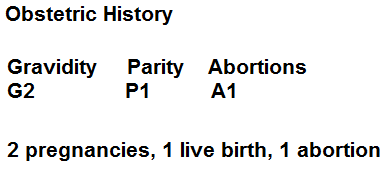GPA System Obstetric History Calculator


The GPA system obstetric history taking calculator calculates the obstetric history of a woman in terms of the number of times she has been pregnant (gravidity), the number of live births she had (parity), and the fetus deaths in utero she has had (abortions). Based on this, the calculator formulates the obstetric history in a "G P A" format, where G is the gravidity, P is the parity, and A is the abortions.
The gravidity is the number of times a woman has been pregnant. If a woman has been pregnant 3 times, her gravidity is 3 (G3).
The parity is the number of live births and stillbirths that a woman has had. So parity includes live health births as well as stillbirths, which is when the baby dies in utero after 20 weeks into the pregnancy. It is important to distinguish that the number of live births per pregnancy can only be 1. It doesn't matter if a woman gives births to twins, triplets, or any other multiples. If a woman has had a successful pregnant with either 1 child, 2 children, 3 children, etc, the parity is 1 for that pregnancy. Thus, if a woman has been pregnant once and gave birth to triplets, she has a gravidity of 1 and a parity of 1 (G1P1). So don't be confused with multiple gestation pregnancies. A successful birth regardless of how many children there are is always 1. Because fetuses are only viable when born after 20 weeks, the child must be born after 20 weeks. A viable pregnancy cannot be performed before 20 weeks, so the child must be delivered after 20 weeks to be viable and be considered a live birth (parity).
The abortions is the number of pregnancies that have been terminated (induced abortion) or the number of pregnancies in which the fetus dies in utero before 20 weeks into the pregnancy. If the fetus dies after 20 weeks into the pregnancy, it is considered a stillbirth. If a woman has been pregnant twice and had a live birth in one pregnancy and an abortion in another, she would have an obstetric history of G2P1A1.
To use this calculator, a user simply enters in the number of pregnancies that a woman has had, the number of live births she's had, and the number of abortions she's had, and clicks the 'Calculate' button. The obstetric history will then be automatically calculated and displayed.
If a woman has not had any abortions, then it's common practice to leave out abortions in the "G P A" format. For example, if a woman has had 2 pregnancies and 2 live births, instead of writing, G2P2A0, it's common practice to just write G2P2. So this calculator follows that convention. If a woman has not had an abortion, the A is simply left out.
An obstetric history serves as a history of a woman's past pregnancies and their outcomes. They can be used to guide a practitoner's monitoring of a woman's current or future pregnancies.
Related Resources
TPAL System Obstetric History Calculator
GTPAL System Obstetric History Calculator
Naegele's Rule Calculator
Bartholomew's Rule of Fourths Calculator
